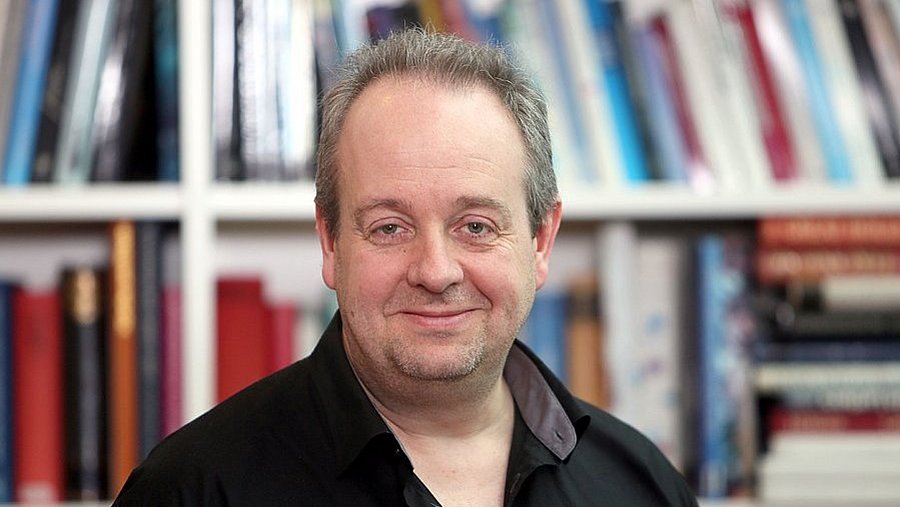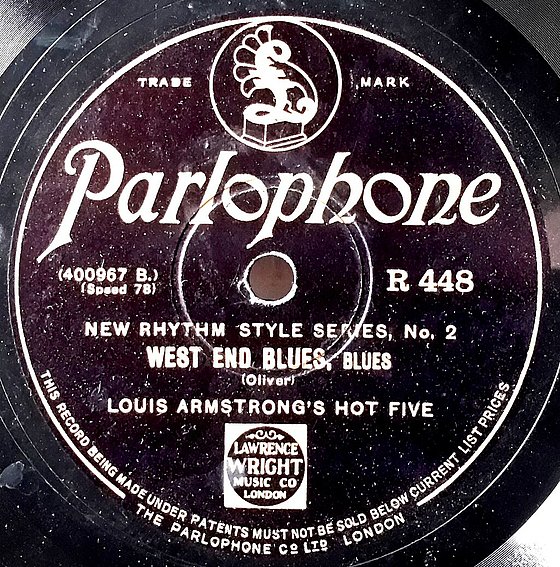
Louis Armstrong and the first studio jazz band
Christoph Spengler / Director of the choir and orchestra of the University of Wuppertal
Photo: Sergej Lepke
Jazz history: Satchmo and the first studio jazz band
Christoph Spengler, director of the Bergische Universität choir and orchestra, on Louis Armstrong, who individualised jazz with the Hot Five
Louis Armstrong is regarded as "The World's Greatest Trumpet Player". What was so extraordinary about his playing style?
Christoph Spengler: Louis Armstrong's musical roots lie in New Orleans jazz. He initially played cornet, but later switched to the more distinctive trumpet. With his opulent improvisations, he liberated the instrument from the pure group playing of New Orleans, pushed the trumpet to the front of the stage and turned solo improvisation into a genuine art form that was suddenly so much more than just adding a few embellishments to the melody. Armstrong understood improvisation as an art of individual expression. He formed singing lines from the notes of his trumpet that sounded like little narratives, with impressive phrasing, powerful rhythmic drive and a previously unheard range. This gave his solos an emotional depth that had never been heard before in jazz. I think it's fair to say that he made a decisive contribution to finally turning jazz into an art form. He is said to have once said: "If it moves the listener, it's entertainment, if not, it's art." I think he showed that there is no contradiction between art and entertainment - at its best, music is both!
Many music lovers also know him by his nickname Satchmo. Where does the term come from?
Christoph Spengler: Louis Armstrong had a remarkably wide mouth. Even as a child he was allegedly called "Gate mouth", later in the 1920s "Satchelmouth", which means "satchel mouth". He was called this affectionately mocking name because he almost opened his "whole face" when he smiled. Another variant, by the way, was "Dippermouth", a name that inspired him to write "Dippermouth Blues".
When Armstrong appeared on his first European tour in London in 1932, he met a journalist, Percy Mathison Brooks, who greeted him with the words "Hello, Satchmo". Louis Armstrong liked this contraction of the word "Satchelmouth" and "adopted" it as a kind of stage name, which he also used in letters and interviews. It thus became the trademark of an unmistakable artistic personality that radiated warmth, humour and joie de vivre in equal measure - as did his music.

Louis Armstrong 1953
Photo: public domain
When he went into the studio as leader of the Hot Five band in 1925, Louis Armstrong was just 24 years old, but was already considered an experienced musician. What was this judgement based on?
Christoph Spengler: Louis Armstrong began making music at a very early age. At the age of 12, he was committed to an institution for homeless African-American youths because he had shot into the air with his uncle's revolver. In this strictly organised home, he learned the basics of playing the cornet and made a living early on by performing as a musician in the city's red-light district. He even claimed to have been born in 1900 - his actual year of birth was 1901 - in order to gain access to the establishments. He soon became well-known in the city, was regarded as one of the greatest talents and played in the best bands on the "Storyville" scene. In 1922, the legendary trumpeter King Oliver brought him to Chicago to join his Creole Jazz Band, which was like a training workshop for young musicians. There Armstrong learnt how to play together professionally, how to work in the studio and he began to develop his own solos. Even at this time, he was spoken of as a man who "brought jazz forward".
By 1925, he had already played in several formations and although he was still young, he was already an experienced professional - matured by hundreds of nights in clubs and dance halls.
The Hot Five were also known as the first jazz band from the retort. What does that mean?
Christoph Spengler: The expression "band from the retort" may sound mocking, but it refers to a development that was new in the history of jazz. The Hot Five (later also Hot Seven, when more musicians were added) were not a regular live band, but a studio formation that had been put together especially for recordings. The musicians had known each other for years and this resulted in an unusual way of working. They did not rehearse the pieces beforehand, but met in the studio and "jammed" with the help of written sketches. The actual arrangements were only created in the studio, often several songs in the course of a few hours. From 1925 to 1928, over 60 titles were recorded in this way. The sound was new to the jazz world, not with the background noises of a bar with an applauding audience, but "cleaner" due to the initially sober studio atmosphere. Armstrong used the studio environment to elaborate the pieces more than would have been possible in a live situation, and thus to a certain extent combined composition and improvisation.
The Hot Five's studio recordings shaped the future of jazz. How do you recognise that?
Christoph Spengler: You could say that Armstrong individualised jazz with the Hot Five. The focus was no longer on the group, but on the individual solo as an expression of personal creativity. Due to the process of creation in the studio with the possibility of recording passages several times, the solos were not purely spontaneous products, but had compositional traits and therefore a clearer and more stirring dramaturgy. This was new in jazz in this form and was absolutely formative for many great jazz musicians who followed him.
The studio sessions also opened new doors in terms of sound. Armstrong experimented with tonal colours, dynamics and rhythm - thus making a decisive contribution to the development of swing.
The distribution of roles in the band also changed. The trumpet was the leading instrument, while the clarinet and trombone provided accompaniment and the banjo and drums took over the rhythmic drive. This new relationship between melody, harmony and rhythm characterised generations of musicians - from Duke Ellington to Charlie Parker and Miles Davis.
The Hot Five's first big hit was recorded in February 1926: "Heebie Jeebies", Armstrong's first vocal recording without a singing partner and also the recording that brought scat singing into the jazz vocabulary. What type of singing is this?
Christoph Spengler: Scat singing is a form of sung improvisation in which the voice is used like an instrument. Instead of a specific text, the improviser uses fantasy syllables such as "ba-da-du" or "doo-bee-doo". This creates melodies and phrasing, and the voice imitates instruments such as the saxophone or trumpet or even enters into a dialogue with them.
Legend has it that Armstrong invented scat singing by accident: During the recording of "Heebie Jeebies", the lyric sheet is said to have fallen out of his hand, so he improvised on with meaningless syllables without further ado. Whether this really happened is debatable, but it describes so well what characterised Armstrong: spontaneous creativity and great joy in playing.
Armstrong brought improvisation into jazz, but that didn't mean spontaneously playing a few nice notes that somehow fit, but making a coherent statement. How did he do that?
Christoph Spengler: For Armstrong, improvisation was much more than just the opportunity to show as much virtuosity as possible in a small space. He saw improvisation more as a kind of musical narrative. The dramaturgy of a solo was therefore important to him, with a beginning, climax and resolution. He thought in phrases, not in individual notes, and built his improvisations on clear melodic motifs, which he repeated, varied and intensified. Here, too, we can see how closely he brought improvisation and composition together.
For all his virtuosity, his solos always had a vocal quality; he imitated the expressive power of the human voice with his trumpet, making his instrument speak, so to speak. His solos told stories, which was new in jazz and still characterises the art of improvisation today.

West End Blues - Contemporary British licence pressing from 1928
Photo: CC BY-SA 4.0
The most famous recording of the Hot Five was made in the summer of 1928. The "West End Blues" is considered "the masterpiece of an era", says German jazz trumpeter Abbi Hübner. What does he mean by that?
Christoph Spengler: Even the beginning of the piece is unusual: the whole band doesn't start, but we hear an introductory trumpet solo for twelve seconds. That was completely new and is still considered one of the most iconic moments in jazz history. In just a few bars, Armstrong demonstrates everything that jazz means to him: power, elegance, freedom and awareness of form. What follows is a wonderfully crafted blues in which everything is just right, just think of the marvellous duet between vocals and clarinet or the impressive, virtuoso solo by pianist Earl Hines - what a lightness, what an elegance, what a wonderful stringency. The band's interplay and musical communication are unique and have become a benchmark for generations of jazz musicians. The piece is an apt example of how jazz became a high art.
Miles Davis, himself a jazz legend, says of Armstrong: "There's nothing on the trumpet that wasn't written by him, not even in the most modern jazz". Would you agree with that?
Christoph Spengler: Absolutely! And it's not just anyone who says that, but a musician whose trumpet playing - like Armstrong's - will always be associated with the concept of jazz. Armstrong was the first - and Miles Davis is alluding to this here - to give the trumpet its own voice in jazz, to free it from pure ensemble playing and make it the protagonist. The great musicians after Armstrong - from Dizzy Gillespie to Miles Davis and Wynton Marsalis - are part of this tradition.
Armstrong developed a technique that set standards, but he didn't use it for its own sake, he used it to let the music tell stories - with an incredible wealth of colour, power, emotionality and a wonderful sense of form and dramaturgy.
I think it's fair to say that Armstrong not only revolutionised the trumpet in jazz, but the musical thinking of jazz itself - moving it away from a casual, rippling form of entertainment music to a respected art form.
Uwe Blass
Christoph Spengler studied church music in Düsseldorf. He took over the direction of the university choir in 2007 and the orchestra in 2011. In 2016, the rectorate awarded him the University of Wuppertal's Medal of Honour. In 2017, he was appointed church music director by the Protestant Church in the Rhineland.
